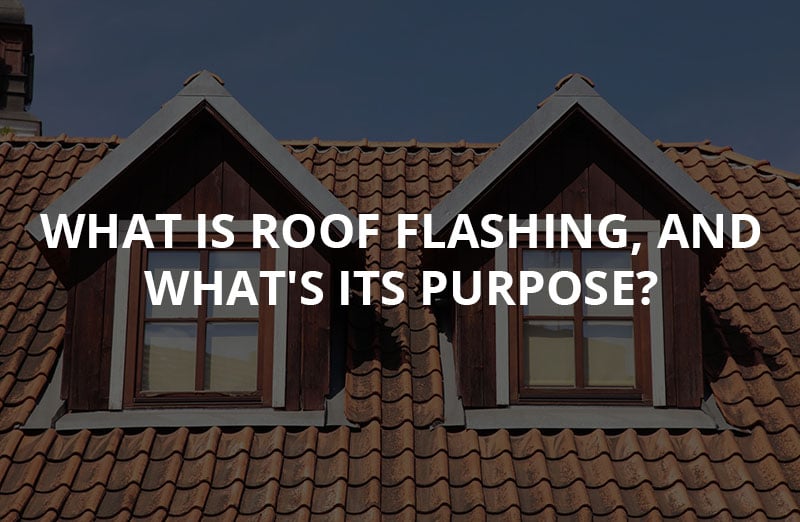
A roof serves as an insulating lid that protects buildings from harsh weather. While roofs may appear to be simple constructions to non-specialists, they are intricate and carefully engineered systems. Flashing is an essential part of every roof system because it reinforces a roof’s most vulnerable areas.
Understanding what flashing is and its purpose will prepare you to make wise roofing decisions that will save you time, money, and aggravation.
What Is Roof Flashing?
Roof flashing is material that covers joints, walls, edges, and other vulnerable areas to protect against water and wind damage. Roof flashing is commonly made with aluminum, galvanized steel, or copper but is sometimes formed with roofing felt, rubber, or plastic. Some of the different types are as follows:
- Wall flashing: Wall flashing is fitted to vertical or near-vertical slopes often created by dormer windows or roof walls.
- Step flashing: Step flashing is a type of wall flashing that slopes along a sidewall.
- Base flashing or continuous flashing: Base flashing or continuous flashing are two different names for wall flashing that is fit to crevasse’s formed parallel to a wall.
- Skylight flashing: Skylight flashing is flashing that is specially designed to fit a particular skylight. Because skylights can be substantially different from one another, skylight flashing is one of the more difficult types of flashing to install.
- Drip Edges: Drip edges are set along edges of a roof and direct water towards gutters protecting against seepage.
- Chimney flashing: Chimney flashing is flashing fit alongside a chimney’s base.
- Valley flashing: Valley flashing is specially formed to reinforce and redirect water away from vulnerable ‘v’ shaped wedges that are part of some roof systems.
- Vent flashing: Vent flashing is flashing that is specially designed to fit a particular roof vent. Because vents are often somewhat unique, vent flashing is harder to often harder to install than other types of flashing.
What Is the Purpose of Flashing on a Roof?
Flashing protects a building from harsh weather. Flashing is made out of durable material that is specially fitted to reinforce the weakest parts of a roof system. Without flashing, roofs would be unable to withstand rain, heavy winds, or the freeze-thaw sequences of winter. Absent flashing, roof systems would quickly fail in the face of anything short of perfect weather.
Common Roof Flashing Issues
There are a variety of reasons flashing can fail. Because flashing is meant to protect the most vulnerable parts of a roof system, it should come as no surprise that flashing itself can face issues.
Improper installation
Improper installation is a common cause of flashing failure. Properly installing flashing is one of the more challenging aspects of roofing. If the flashing is installed improperly, it can quickly deteriorate or fail to perform its function from the onset.
Human-caused damage
When people unfamiliar with roofs stand on them, they often cause damage. Flashing is a roof component commonly damaged by misplaced steps. While roof flashing is weather resilient, it is often made from pliable materials. The weight of a person standing on flashing can be sufficient for causing damage.
Severe weather
Flashing is designed to protect roofs from rain, ice, snow, and wind, but it is not invincible. If the weather is harsh enough, it can damage, destroy, or even wholly remove flashing from a roof.
Normal Wear
After a long enough stretch, flashing will succumb to age and will require repair or replacement.
How Long Should Roof Flashing Last?
Any competent roofer wouldn’t fit a home with flashing material that isn’t expected to last as long as the rest of a roof. That said, there is a wide variety of flashing materials and flashing forms that have wide-ranging life spans. In general, you should expect your roof flashing to last between 15-80 years. If you want a more accurate life-span estimate, you should speak to an experienced roofer familiar with your roof. It is also essential to understand that even the most resilient flashing may need repair within its lifespan.
How Much Does It Cost to Fix or Repair Roof Flashing?
Repairing damaged flashing should cost roughly $40-$80 per hour in labor plus the cost of the materials used for repair. Material costs can vary from job to job, but labor will likely be your highest expense. This might change if you use a more expensive flashing material. On the other hand, your labor costs could be substantially higher if you have a complicated roof or if your roof has extensive damage due to poor flashing.
How Much Does It Cost to Replace Roof Flashing?
In terms of material cost, replacing damaged flashing shouldn’t cost much more than repairing damaged flashing. Replacement should cost more than a repair, but the higher price will mostly be due to increased labor costs. Replacing your flashing will likely cost somewhere between $300-$800 depending upon the amount of labor and materials used.
If you have experience with roof repair and decide to replace your flashing, you will significantly cut the cost of replacement. However, it is probably a bad idea to take on a flashing replacement project yourself. Given the importance of flashing, it is worth paying to have a professional roofer replace your flashing.
Flashing is an integral part of a roof system. Knowing more about flashing equips you to make informed roofing decisions. Nevertheless, there is no replacement for the input of an expert. Given the structural importance of flashing, it is never a bad idea to contact a roofing professional for roofing advice.





